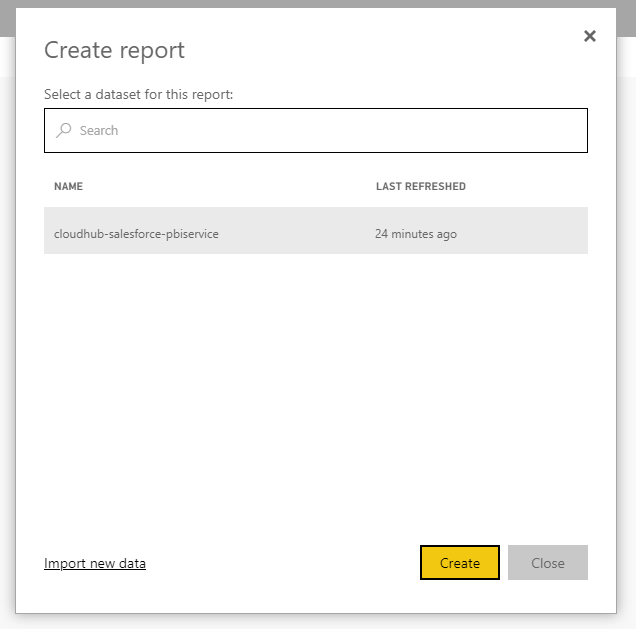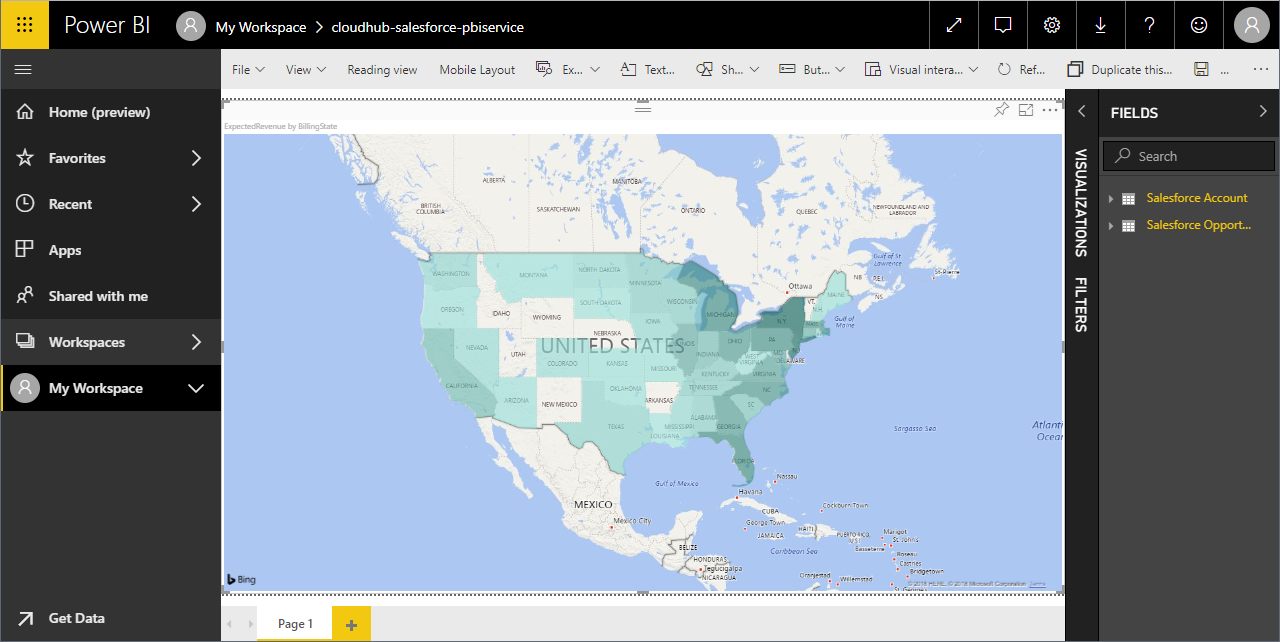Discover how a bimodal integration strategy can address the major data management challenges facing your organization today.
Get the Report →Visualize Live Amazon Athena Data in the Power BI Service
Use CData Connect Cloud to connect to live Amazon Athena data and create custom reports in the Power BI Service through the On-Premises Gateway.
Power BI transforms your company's data into rich visuals for you to collect and organize so you can focus on what matters to you. When paired with CData Connect Cloud, you get instant access to Amazon Athena data for visualizations, dashboards, and more. This article shows how to build and publish a dataset from Amazon Athena data in Power BI and then create reports on Amazon Athena data in the Power BI service.
CData Connect Cloud provides a pure SQL interface for Amazon Athena, allowing you to easily build reports from live Amazon Athena data in Power BI — with no need to replicate the data. As you build visualizations, Power BI generates SQL queries to gather data. Using optimized data processing out of the box, CData Connect Cloud pushes all supported SQL operations (filters, JOINs, etc) directly to Amazon Athena, leveraging server-side processing to quickly return Amazon Athena data.
NOTE: You can also import Amazon Athena data into Power BI through Connect Cloud (instead of using the on-premise gateway). Read how in the related Knowledge Base article.
Configure Amazon Athena Connectivity for Power BI
Connectivity to Amazon Athena from Power BI is made possible through CData Connect Cloud. To work with Amazon Athena data from Power BI, we start by creating and configuring a Amazon Athena connection.
- Log into Connect Cloud, click Connections and click Add Connection
![Adding a Connection]()
- Select "Amazon Athena" from the Add Connection panel
![Selecting a data source]()
-
Enter the necessary authentication properties to connect to Amazon Athena.
Authenticating to Amazon Athena
To authorize Amazon Athena requests, provide the credentials for an administrator account or for an IAM user with custom permissions: Set AccessKey to the access key Id. Set SecretKey to the secret access key.
Note: Though you can connect as the AWS account administrator, it is recommended to use IAM user credentials to access AWS services.
Obtaining the Access Key
To obtain the credentials for an IAM user, follow the steps below:
- Sign into the IAM console.
- In the navigation pane, select Users.
- To create or manage the access keys for a user, select the user and then select the Security Credentials tab.
To obtain the credentials for your AWS root account, follow the steps below:
- Sign into the AWS Management console with the credentials for your root account.
- Select your account name or number and select My Security Credentials in the menu that is displayed.
- Click Continue to Security Credentials and expand the Access Keys section to manage or create root account access keys.
Authenticating from an EC2 Instance
If you are using the CData Data Provider for Amazon Athena 2018 from an EC2 Instance and have an IAM Role assigned to the instance, you can use the IAM Role to authenticate. To do so, set UseEC2Roles to true and leave AccessKey and SecretKey empty. The CData Data Provider for Amazon Athena 2018 will automatically obtain your IAM Role credentials and authenticate with them.
Authenticating as an AWS Role
In many situations it may be preferable to use an IAM role for authentication instead of the direct security credentials of an AWS root user. An AWS role may be used instead by specifying the RoleARN. This will cause the CData Data Provider for Amazon Athena 2018 to attempt to retrieve credentials for the specified role. If you are connecting to AWS (instead of already being connected such as on an EC2 instance), you must additionally specify the AccessKey and SecretKey of an IAM user to assume the role for. Roles may not be used when specifying the AccessKey and SecretKey of an AWS root user.
Authenticating with MFA
For users and roles that require Multi-factor Authentication, specify the MFASerialNumber and MFAToken connection properties. This will cause the CData Data Provider for Amazon Athena 2018 to submit the MFA credentials in a request to retrieve temporary authentication credentials. Note that the duration of the temporary credentials may be controlled via the TemporaryTokenDuration (default 3600 seconds).
Connecting to Amazon Athena
In addition to the AccessKey and SecretKey properties, specify Database, S3StagingDirectory and Region. Set Region to the region where your Amazon Athena data is hosted. Set S3StagingDirectory to a folder in S3 where you would like to store the results of queries.
If Database is not set in the connection, the data provider connects to the default database set in Amazon Athena.
![Configuring a connection (Salesforce is shown)]()
- Click Create & Test
- Navigate to the Permissions tab in the Add Amazon Athena Connection page and update the User-based permissions.
![Updating permissions]()
Add a Personal Access Token
If you are connecting from a service, application, platform, or framework that does not support OAuth authentication, you can create a Personal Access Token (PAT) to use for authentication. Best practices would dictate that you create a separate PAT for each service, to maintain granularity of access.
- Click on your username at the top right of the Connect Cloud app and click User Profile.
- On the User Profile page, scroll down to the Personal Access Tokens section and click Create PAT.
- Give your PAT a name and click Create.
![Creating a new PAT]()
- The personal access token is only visible at creation, so be sure to copy it and store it securely for future use.
With the connection configured, you are ready to connect to Amazon Athena data from Power BI.
Connecting to Connect Cloud from Power BI
To connect to and visualize live Amazon Athena data in the Power BI service), install the on-premise data gateway, add a data source to the gateway from the Power BI service, and publish a dataset from Power BI Desktop to the service.
Install the On-Premises Data Gateway
The Microsoft on-premise data gateway provides secure data transfer between connected data sources and various cloud-based Microsoft tools and platforms. You can read more about the gateway in the Microsoft documentation.
You can download and install the gateway from the Power BI service:
- Log in to PowerBI.com.
- Click the Download menu and click Data Gateway.
![Download the Data Gateway]()
- Follow the instructions for installation, making note of the name of the gateway.
Add Amazon Athena as a Data Source to the Power BI Service
Once you have installed the data gateway, you add Connect Cloud as a data source to the Power BI service:
- Log in to PowerBI.com.
- Click the Settings menu and click "Manage gateways."
![Settings -> Manage gateways]()
- Click "ADD DATA SOURCE" and configure the connection to Connect Cloud:
- Set Data Source Name to something like ConnectCloudAmazonAthena.
- Choose SQL Server as the Data Source Type.
- Set Server to tds.cdata.com,14333.
- Set Database to the name of your Amazon Athena connection (e.g. AmazonAthena1).
- Set Authentication Method to Basic.
- Set Username to a Connect Cloud user (e.g. user@mydomain.com)
- Set Password to the PAT for the user above.
Publish a Dataset from Power BI Desktop
With the gateway installed and Connect Cloud added as a datasource to the Power BI service, you can publish a dataset from Power BI Desktop to the service.
- Open Power BI, click Get Data -> More, then select SQL Server database, and click Connect.
- Set the connection properties and click OK.
- Set Server to tds.cdata.com,14333.
- Set Database to the name of your Amazon Athena connection (e.g. AmazonAthena1).
- Set Data Connectivity mode to DirectQuery*.
![Connect to CData Connect Cloud instance]() * DirectQuery enables live query processing and real-time visualizations of Amazon Athena data.
* DirectQuery enables live query processing and real-time visualizations of Amazon Athena data.
- In the authentication wizard, select Database, set the User name and Password properties, and click Connect.
- Select the table(s) to visualize in the Navigator dialog.
- In the Query Editor, you can customize your dataset by filtering, sorting, and summarizing Amazon Athena columns. Click Edit to open the query editor. Right-click a raw to filter the rows. Right-click a column header to perform options like the following:
- Change column data types
- Remove a column
- Group by columns
Power BI detects each column's data type from the Amazon Athena metadata reported by Connect Cloud.
Power BI records your modifications to the query in the Applied Steps section, adjusting the underlying data retrieval query that is executed to the remote Amazon Athena data. When you click Close and Apply, Power BI executes the data Retrieval query.
Otherwise, click Load to pull the data into Power BI.
- Define any relationships between the selected entities on the Relationships tab.
- Click Publish (from the Home menu) and select a Workspace.
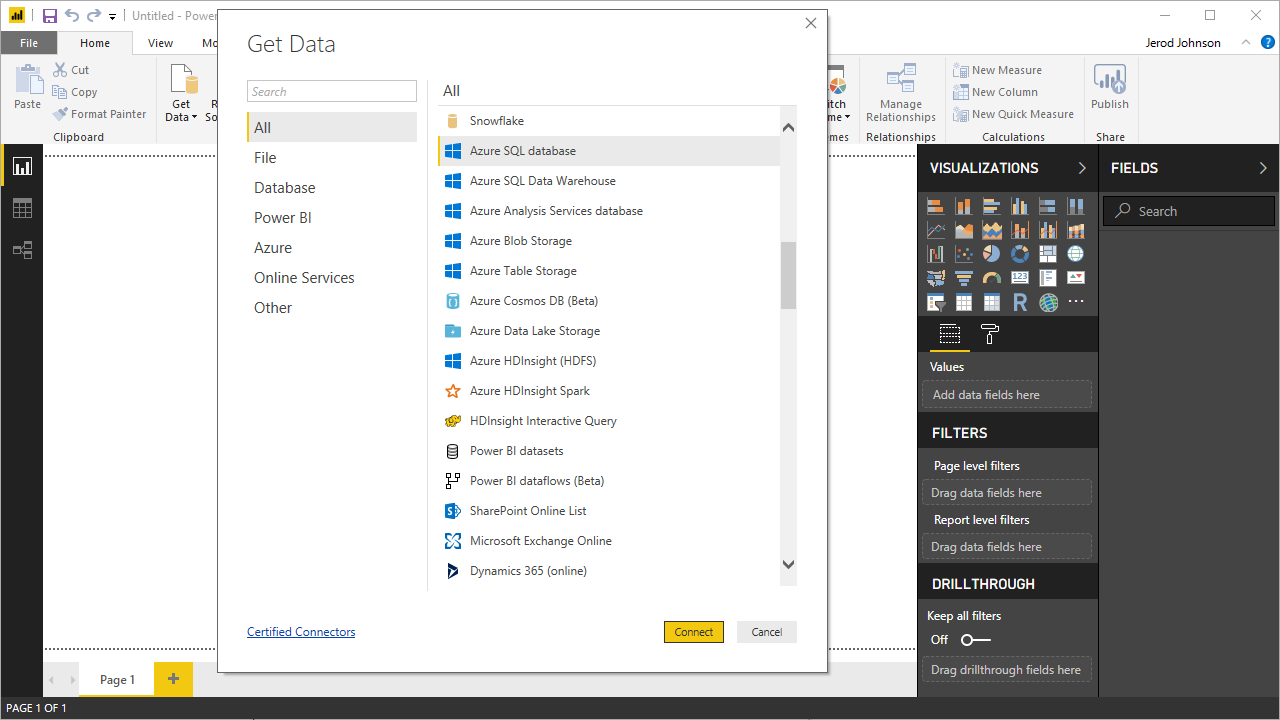
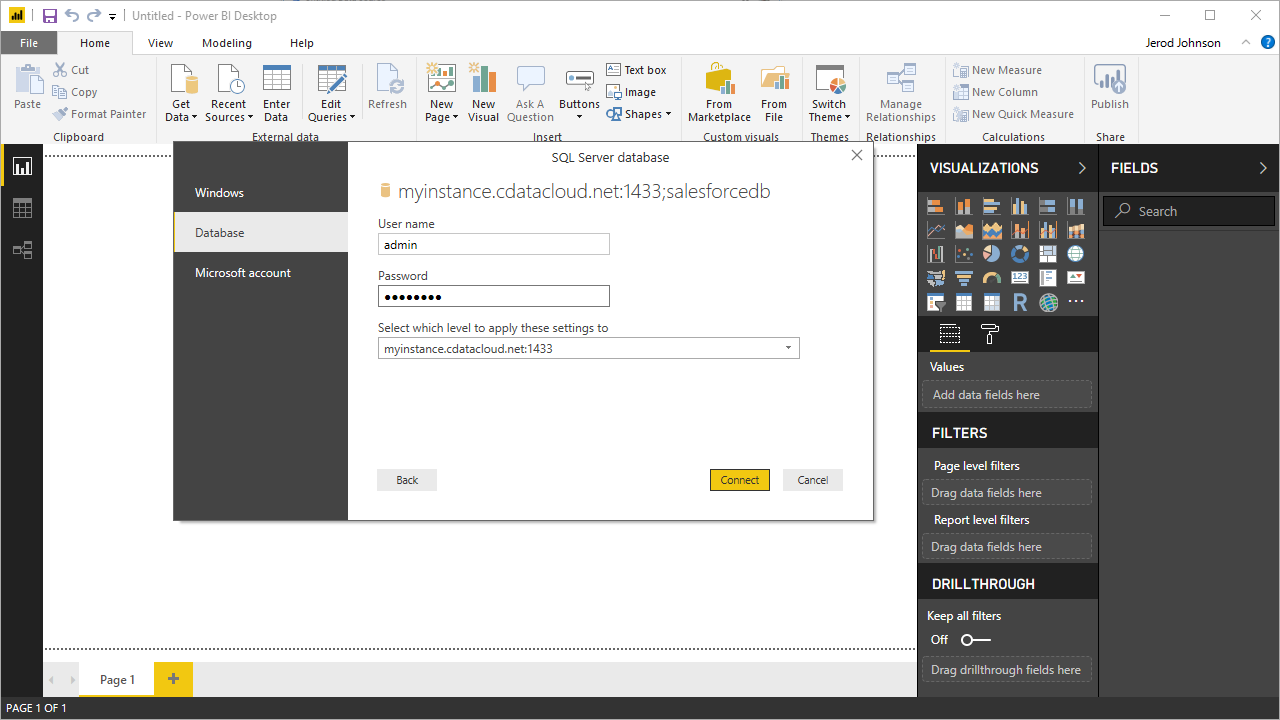
Build Reports and Dashboards on Amazon Athena Data in the Power BI Service
Now that you have published a dataset to the Power BI service, you can create new reports and dashboards based on the published data:
- Log in to PowerBI.com.
- Click Workspaces and select a workspace.
- Click Create and select Report.
- Select the published dataset for the report.
![Select a dataset]()
- Choose fields and visualizations to add to your report.
![Visualizing Amazon Athena data in the Power BI service]()
Live Access to Amazon Athena Data from Cloud Applications
Now you have a direct connection to live Amazon Athena data from the Power BI service. You can create more data sources and new visualizations, build reports, and more — all without replicating Amazon Athena data.
To get live data access to 100+ SaaS, Big Data, and NoSQL sources directly from your cloud applications, sign up for a free trial of CData Connect Cloud.











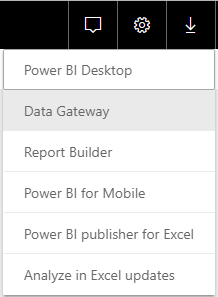
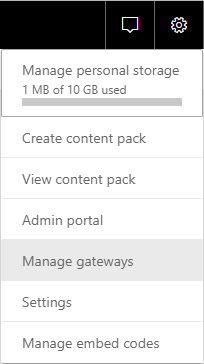
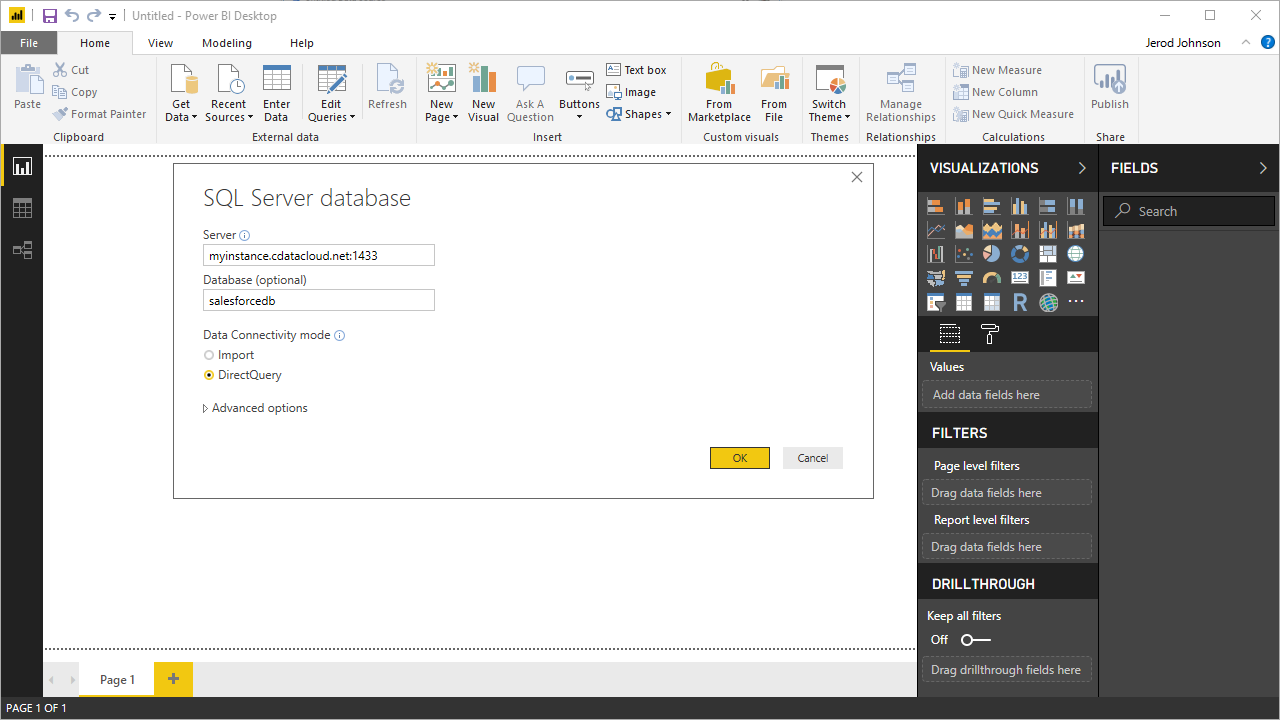 * DirectQuery enables live query processing and real-time visualizations of Amazon Athena data.
* DirectQuery enables live query processing and real-time visualizations of Amazon Athena data.
